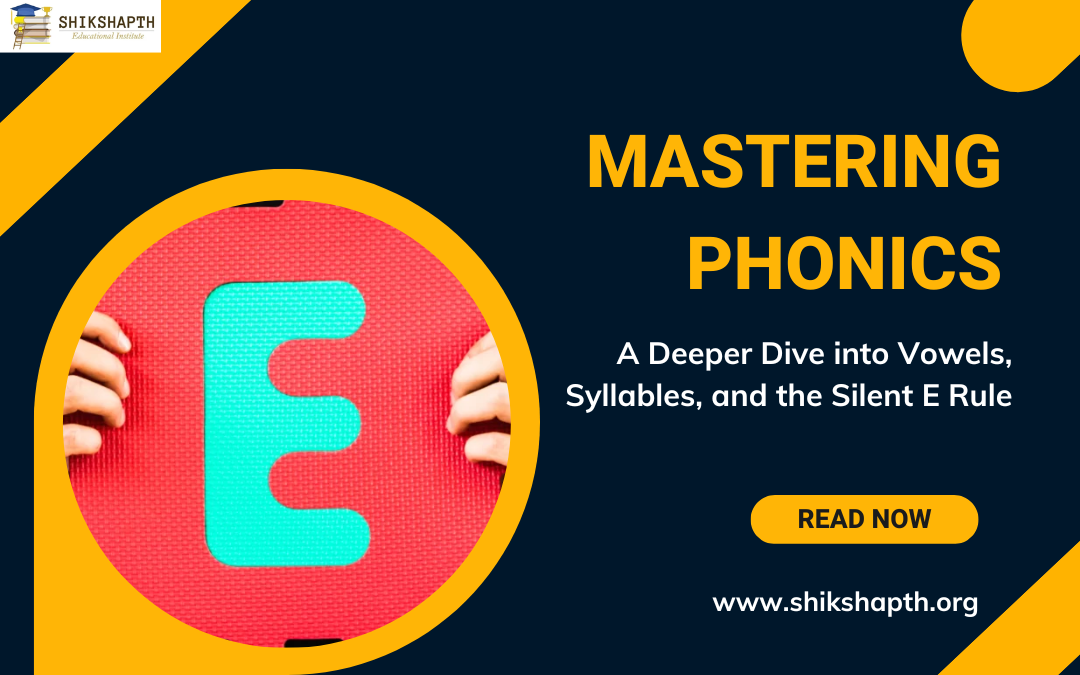Phonics forms the backbone of reading and language comprehension. In this expanded exploration for Shikshapth learners, we delve deeper into the roles of vowels in syllables, the contrasting sounds of short and long vowels, and the transformative silent ‘e’ rule. This comprehensive guide aims to enhance your understanding of these key phonetic concepts.
1.Vowels in Syllables: The Pulse of Pronunciation
The presence of vowels in syllables is a cornerstone of English phonetics. Each syllable, the rhythmic units of spoken language, relies on at least one vowel sound for its formation.
- Vowel Diversity in Syllables: Vowels are the most flexible elements in phonetics. They can be the solo performers in a syllable, carrying the weight of pronunciation on their own, like the ‘e’ in ‘me’. Alternatively, they often find themselves in the company of consonants, either at the beginning, as in ‘apple’, or sandwiched between consonants, as in ‘sand’. This adaptability of vowels in various syllabic structures adds richness and variety to the spoken language.
Vowels in syllables are fundamental to the structure and rhythm of English phonetics. Each syllable, as a unit of sound in spoken language, is defined by the presence of a vowel sound. The flexibility of vowels in phonetics is unparalleled. They can function independently in a syllable, carrying the entire phonetic load, such as the long ‘e’ in ‘be’ or ‘scene’. In contrast, vowels can be integrated within a cluster of consonants, playing a crucial role in the articulation and tonality of the syllable. For instance, in ‘crisp’, the vowel ‘i’ is flanked by consonants, creating a specific sound pattern. This adaptability contributes significantly to the phonetic diversity of English, influencing both pronunciation and intonation.
Also read – What is Phonics?
2. Short and Long Vowels: The Dual Nature
Vowels exhibit a duality in their sounds, influenced significantly by their position and the structure of syllables.The dual nature of vowels, manifested in their ability to produce short and long sounds, is a key aspect of phonetic variation and is largely determined by syllabic structure.
- Short Vowel Sounds Explored: In closed syllables, vowels are typically followed by one or more consonants, leading to a shorter sound. This is an essential aspect of phonemic awareness. For example, the ‘u’ in ‘bug’ and ‘e’ in ‘red’ demonstrate these brisk, compact sounds.
- The World of Long Vowels: When vowels appear in open syllables, where they are not immediately followed by a consonant, they tend to pronounce their names, emitting their long sounds. This phenomenon is observable in words like ‘silent’ (where the ‘i’ is pronounced as ‘ai’) and ‘no’ (where the ‘o’ is pronounced as ‘oh’).
3. The Silent E Rule: Unveiling Long Vowels
The silent ‘e’ rule is a transformative aspect of phonics, particularly influential in altering vowel sounds.The silent ‘e’ rule represents a critical phonological phenomenon in English, influencing vowel sound and word meaning.
- Silent E in Action: This rule is a critical component of phonemic understanding. The silent ‘e’ at the end of words serves as an indicator, changing the sound of the vowel preceding it from short to long without being pronounced itself. This rule not only alters the sound of a word but often its meaning as well, as seen in the difference between ‘cap’ and ‘cape’. In ‘cape’, the silent ‘e’ extends the ‘a’ sound, modifying the entire word’s pronunciation and meaning.
Also read – Secrets of Phonics: A Comprehensive Guide for Parents and Educators
Conclusion
A deeper understanding of these phonetic principles is key to mastering the complexities of the English language. Recognizing the role of vowels in syllables, distinguishing between short and long vowel sounds, and comprehending the silent ‘e’ rule are not just theoretical concepts. They are practical, foundational tools for effective reading, spelling, and communication.
This in-depth exploration of phonics, focusing on the intricacies of vowels in syllables, the nuanced duality of short and long vowel sounds, and the transformative power of the silent ‘e’, aims to deepen understanding and enhance linguistic proficiency. Recognizing these elements is vital for developing advanced reading skills and a thorough grasp of English phonetics.
Shikshapth is committed to providing resources and guidance that enrich your language learning experience. Continue exploring the world of phonics and embrace the journey of becoming proficient in the art of reading and communication!
Stay engaged with Shikshapth for more insightful educational content and resources.




Recent Comments